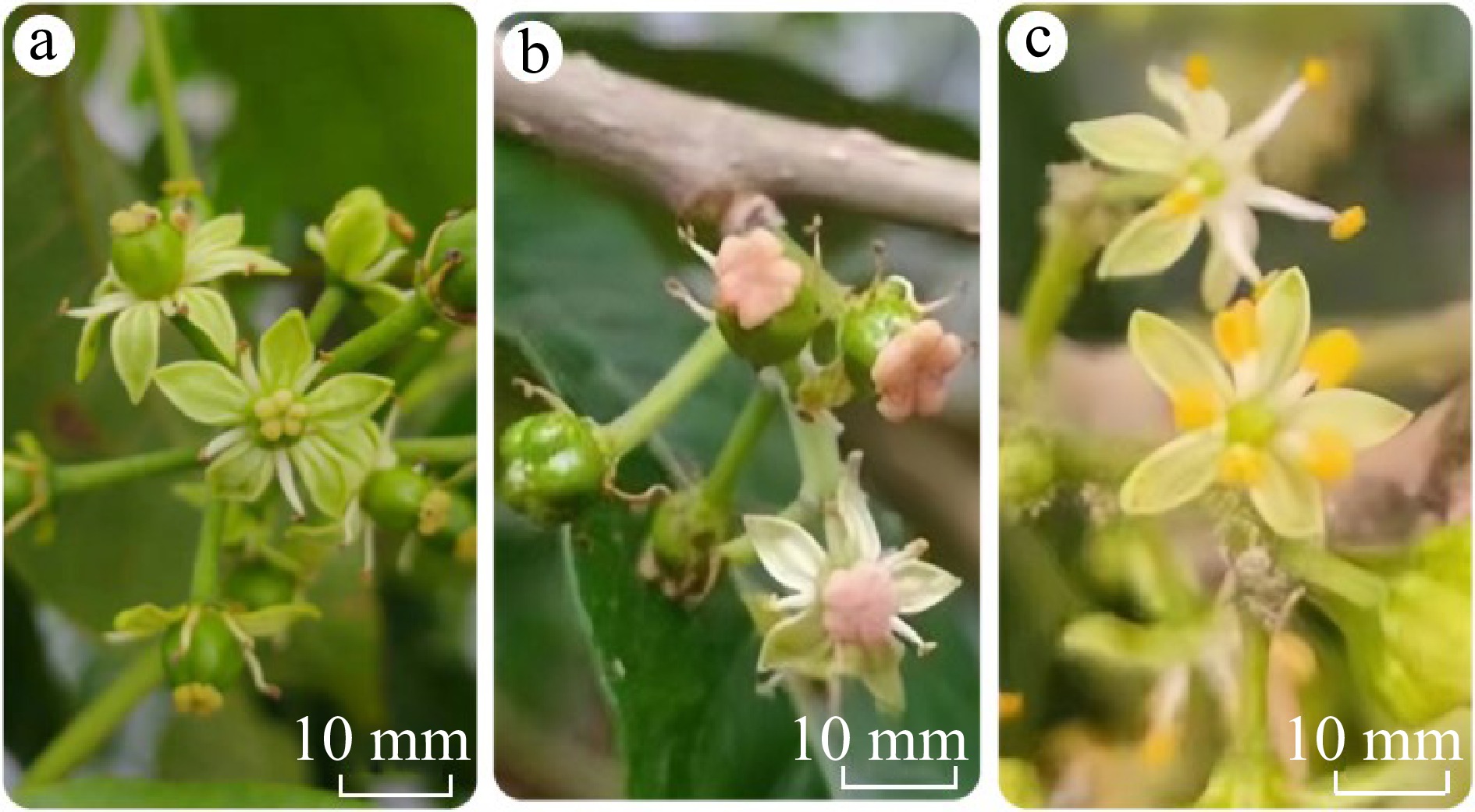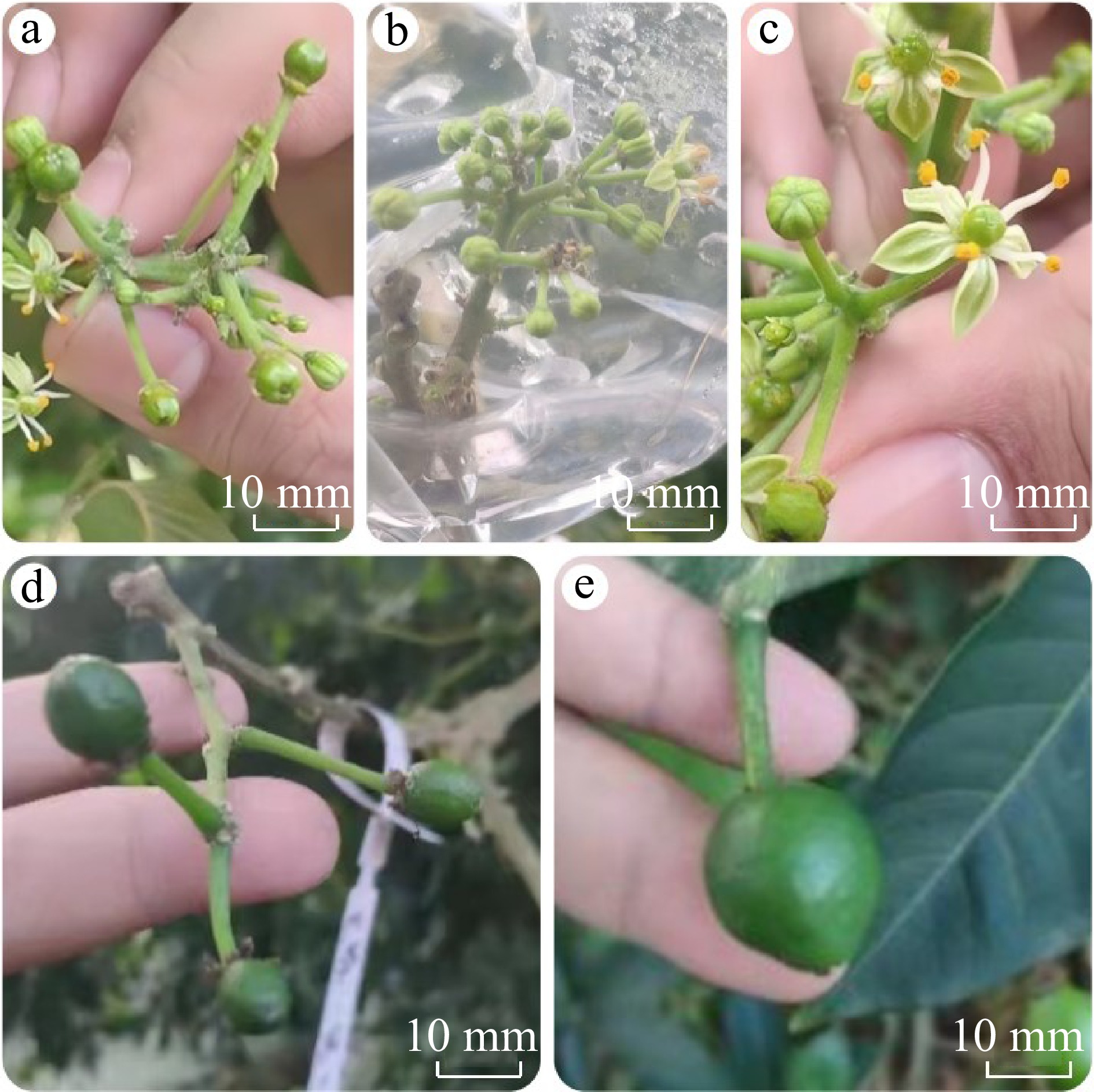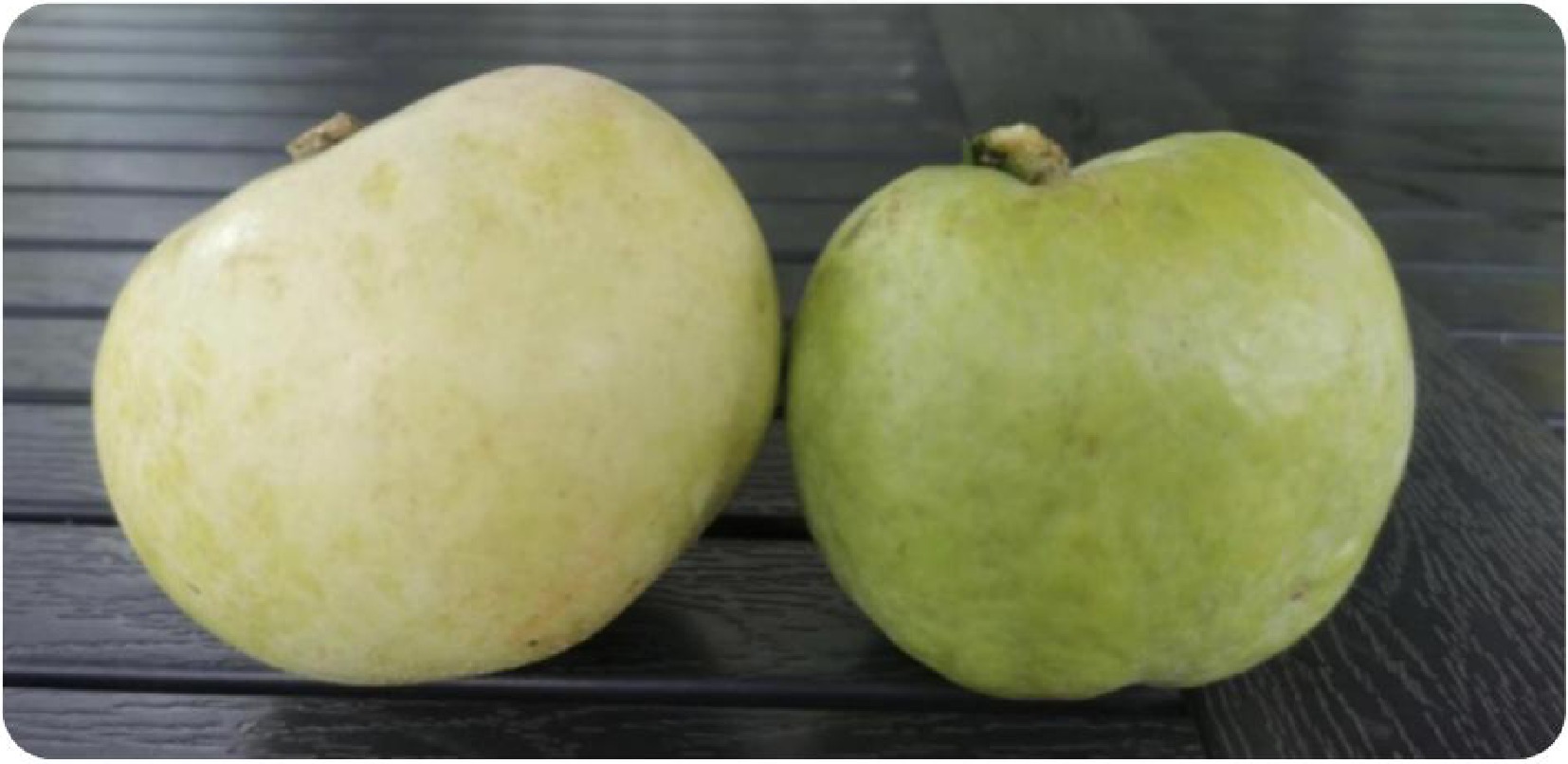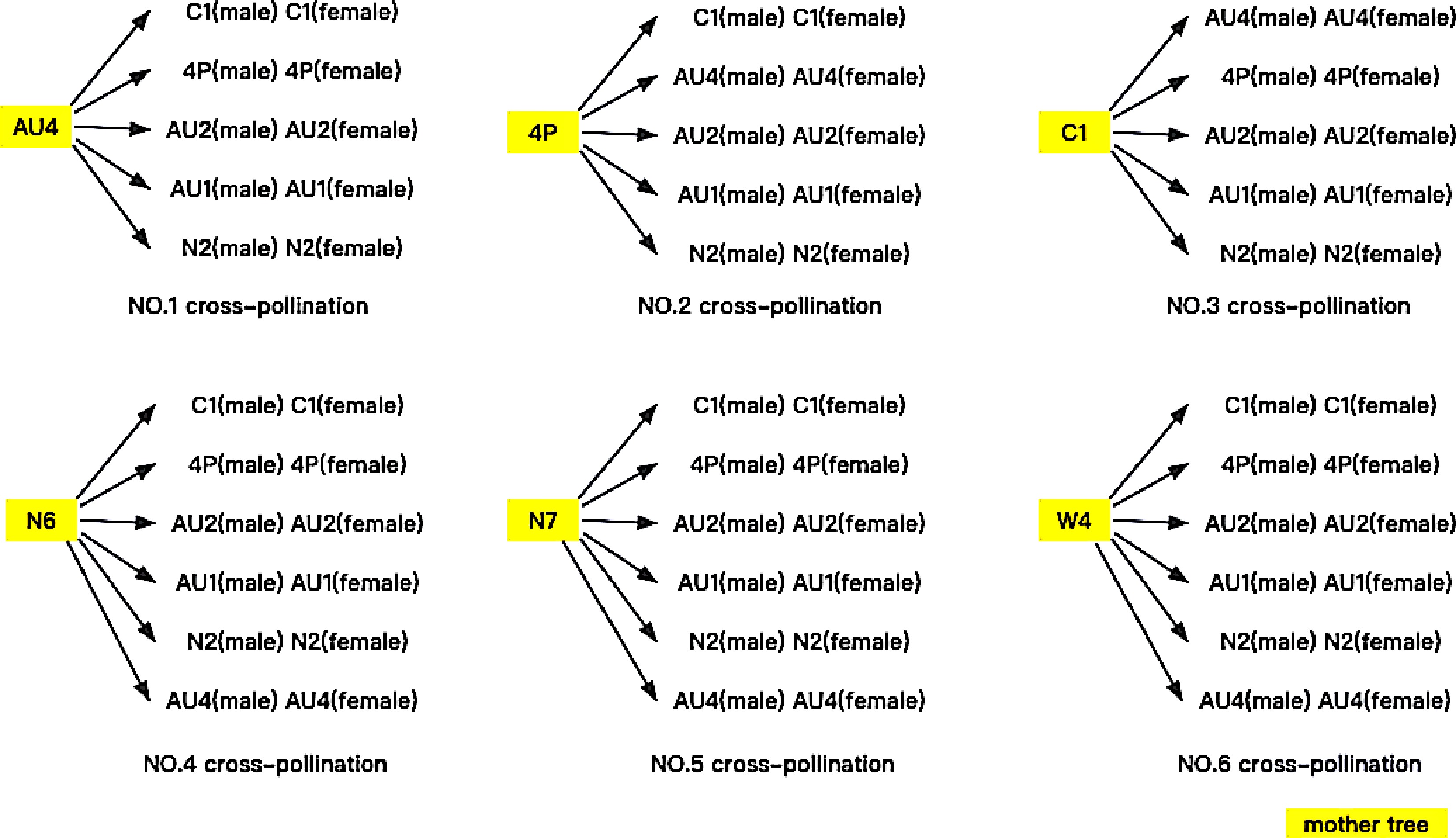-

Figure 1.
(a) Ice cream fruit. (b) Peeled ice cream fruit. (c) Ice cream tree flower.
-

Figure 2.
(a) W4 variety – no pollen. (b) 4P variety – little pollen. (c) AU2 variety – abundant pollen.
-

Figure 3.
The natural development process of self-pollinated fruit.
-

Figure 4.
Hybrid fruit of 4P and N2.
-

Figure 5.
Artificial cross-pollination (male/female).
-
Breed Rate of fruit set
(%)Width
(cm)Length
(cm)Sugar
(%)Abundant pollen AU1 0% − − − AU2 25% 4.1 ± 0 4 ± 0 10.7 ± 0 N2 50% 4.7 ± 0.2 3.95 ± 0.25 9.1 ± 0.1 Little pollen 4P 66% 7.5 ± 0.2 6.9 ± 0.1 11.7 ± 0.5 AU4 50% 8.3 ± 0.2 7.6 ± 0.3 10.5 ± 05 C1 100% 6.6 ± 0.2 5 ± 0.1 10.9 ± 0.1 Table 1.
Statistics of the naturally self-pollinated fruit.
-
Breed Fruit set
(%)Width
(cm)Length
(cm)Sugar
(%)Abundant pollen AU1 33% 5.9 ± 0 5.5 ± 0 10.0 ± 0 AU2 50% 4.4 ± 0.5 4.0 ± 0.1 9.5 ± 0.5 N2 40% 6.0 ± 0 4.5 ± 0 8.6 ± 0 Little pollen 4P 66% 7.7 ± 0.1 6.4 ± 0.8 11.0 ± 1.0 AU4 50% 8.9 ± 0.1 7.5 ± 0.1 10.2 ± 0.2 C1 100% 7.8 ± 0.1 6.9 ± 0.1 9.5 ± 0.1 Table 2.
Statistics of experimental data of artificial self pollination.
-
Group Mother tree Father tree Fruit set (%) Length (cm) Width (cm) Sugar (%) Female AU4 (little pollen) Little pollen C1 33% 7.5 ± 0.1 7.4 ± 0.1 8.9 ± 0.1 4P 50% 8.8 ± 0.2 7.9 ± 0.2 10.4 ± 0.1 Abundant pollen AU1 40% 8.15 ± 0.1 7.75 ± 0.1 10.4 ± 0.2 AU2 50% 9.2 ± 0.1 7.95 ± 0.1 9.5 ± 0.1 N2 75% 9.47 ± 0.1 8.47 ± 0.1 10.5 ± 0.5 Male Little pollen C1 0% − − − 4P 50% 8.05 ± 0.1 7.95 ± 0.2 8.5 ± 1 Abundant pollen AU1 33% 8.7 ± 0.2 8.5 ± 0.1 8.0 ± 2 AU2 33% 8.5 ± 0.3 7.9 ± 0.1 8.1 ± 0.2 N2 50% 9.2 ± 0.3 8.04 ± 1 8.5 ± 1 Table 3.
Experimental data for the cross-pollination with AU4 as the maternal parent, with and without emasculation.
-
Group Mother tree Father tree Fruit set (%) Length (cm) Width (cm) Sugar (%) Female 4P (little pollen) Little pollen C1 50% 7.8 ± 0.6 7.0 ± 0.2 9.8 ± 1.2 AU4 66% 6.9 ± 0.1 6.3 ± 0.2 8.78 ± 1.0 Abundant pollen AU1 50% 8.7 ± 0.6 6.57 ± 1.0 9.8 ± 0.5 AU2 50% 7.35 ± 0.2 6.45 ± 2.0 8.5 ± 1.5 N2 80% 7.7 ± 1.0 7.075 ± 1.0 11.0 ± 1.0 Male Little pollen C1 42% 8.5 ± 0.3 6.9 ± 0.2 10.5 ± 0.5 AU4 50% 8.0 ± 2.0 7.95 ± 2.0 10.0 ± 0.8 Abundant pollen AU1 50% 7.15 ± 2.0 6.55 ± 3.0 9.2 ± 0.6 AU2 42% 6.8 ± 0.4 6.1 ± 0.5 8.87 ± 0.4 N2 62% 7.5 ± 0.3 7.4 ± 0.6 9.84 ± 0.3 Table 4.
Experimental data for the cross-pollination with 4P as the maternal parent, with and without emasculation.
-
Group Mother tree Father tree Fruit set (%) Length (cm) Width (cm) Sugar (%) Female C1 (little pollen) Little pollen AU4 60% 7.27 ± 1.0 6.76 ± 1.0 10.3 ± 1.0 4P 33% 6.9 ± 0.4 5.9 ± 0.3 10.0 ± 0.5 Abundant pollen AU1 25% 6.8 ± 0.5 6.2 ± 0.6 8.0 ± 0.4 AU2 33% 5.9 ± 0.4 5.9 ± 0.3 10.2 ± 1.0 N2 50% 6.8 ± 0.6 6.8 ± 0.3 11.0 ± 0.5 Male Little pollen AU4 50% 6.9 ± 0.2 6.8 ± 0.4 10.3 ± 1.0 4P 0% − − − Abundant pollen AU1 0% − − − AU2 33% 6.8 ± 0.4 5.9 ± 0.1 10.0 ± 0.5 N2 50% 7.1 ± 0.5 5.9 ± 0.2 9.16 ± 1.0 Table 5.
Experimental data for the cross-pollination with C1 as the maternal parent, with and without emasculation.
-
Group Mother tree Father tree Fruit set (%) Length (cm) Width (cm) Sugar (%) Female N6 (No pollen) Little pollen C1 0% − − − 4P 40% 7.0 ± 0.5 6.5 ± 0.2 8.75 ± 1.0 AU4 50% 6.8 ± 0.2 6.3 ± 0.2 10.0 ± 0.4 Abundant pollen AU1 50% 7.2 ± 0.2 5.9 ± 0.3 8.2 ± 0.2 AU2 33% 5.8 ± 0.4 6.2 ± 0.4 8.0 ± 1.0 N2 50% 6.9 ± 0.2 6.7 ± 0.3 10.0 ± 0.6 Male Little pollen C1 50% 6.6 ± 0 6.5 ± 0 8.0 ± 0 4P 33% 7.4 ± 0 6.5 ± 0 9.5 ± 0 AU4 33% 6.5 ± 0.15 6.4 ± 0.4 8.0 ± 1.0 Abundant pollen AU1 66% 6.6 ± 0.5 5.95 ± 0.1 9.5 ± 0.5 AU2 50% 6.6 ± 0.1 6.45 ± 0.1 0.59 ± 0.5 N2 66% 6.6 ± 0.6 5.95 ± 0.1 10.5 ± 1 Table 6.
Experimental data for the cross-pollination with N6 as the maternal parent, with and without emasculation.
-
Group Mother tree Father tree Fruit set (%) Length (cm) Width (cm) Sugar (%) Female N7 (No pollen) Little pollen C1 50% 6.8 ± 0.2 6.4 ± 0.2 10 ± 0.4 4P 33% 7.2 ± 0.2 6.8 ± 0.2 9.4 ± 0.4 AU4 33% 6.4 ± 0.2 6.2 ± 0.4 9.4 ± 0.4 Abundant pollen AU1 33% 6.7 ± 0.3 6.6 ± 0.6 10.0 ± 0.2 AU2 33% 7.8 ± 0.4 6.8 ± 0.5 9.0 ± 1.0 N2 50% 8.8 ± 0.4 7.4 ± 0.1 9.5 ± 1.0 Male Little pollen C1 28% 5.8 ± 0.1 5.6 ± 0 8.5 ± 0.5 4P 50% 7.2 ± 0 6.8 ± 0 10.0 ± 0 AU4 25% 6.4 ± 0 6.3 ± 0 8.4 ± 0 Abundant pollen AU1 0% − − − AU2 40% 6.8 ± 0 6.1 ± 0 9.0 ± 0 N2 50% 6.8 ± 0.4 6.0 ± 0.2 10.0 ± 1.0 Table 7.
Experimental data for the cross-pollination with N7 as the maternal parent, with and without emasculation.
-
Group Mother tree Father tree Fruit set (%) Length (cm) Width (cm) Sugar (%) Female W4 (No pollen) Little pollen C1 60% 7.2 ± 0 6.5 ± 0 16.0 ± 0 4P 50% 6.3 ± 0.3 5.8 ± 0.1 13.5 ± 0.5 AU4 0% − − − Abundant pollen AU1 50% 5.6 ± 0 5.4 ± 0.2 10.7 ± 0.3 AU2 50% 7.1 ± 0 6.2 ± 0 13.0 ± 0 N2 60% 6.8 ± 0.2 6.0 ± 0.1 14.2 Male Little pollen C1 25% 7.1 ± 0.3 6.4 ± 0.2 13.7 ± 1.0 4P 50% 7.0 ± 0.1 6.4 ± 0 11.7 ± 0.6 AU4 0% − − − Abundant pollen AU1 50% 6.9 ± 0 6.8 ± 0 12.8 ± 0 AU2 50% 5.8 ± 0 4.9 ± 0 13.6 ± 0 N2 60% 7.1 ± 0.6 6.0 ± 0.3 12.8 ± 0.2 Table 8.
Experimental data for the cross-pollination with W4 as the maternal parent, with and without emasculation.
-
Cross Fruit set (%) Length (cm) Width (cm) Sugar
(%)Index of
fruit qualityMother tree Father tree C1 AU4 60% 7.2 ± 1.0 6.7 ± 1.0 10.3 ± 1.0 10.2 4P N2 80% 7.7 ± 1.0 7.1 ± 1.0 11.0 ± 1.0 14.4 AU4 N2 75% 9.4 ± 0.1 8.4 ± 0.1 10.5 ± 0.5 14.2 N6 N2 50% 6.6 ± 0.6 5.9 ± 0.1 10.5 ± 1.0 8.3 N7 N2 50% 8.8 ± 0.4 7.4 ± 0.1 9.5 ± 1.0 8.5 W4 C1 60% 7.2 ± 0 6.5 ± 0 16.0 ± 0 13.5 Table 9.
Male parent cultivars and index of the best cultivar pairing for each female parent cultivar with emasculation.
-
Different varieties Different applications Abundant pollen varieties (N2, AU1 and AU2) Observation of natural self-pollination 3 Artificial self-pollination 3 Artificial cross-pollination parent tree 3 Little-pollen varieties (AU4,
4P and C1)Artificial cross-pollination mother tree (male) 3 Artificial cross-pollination mother tree (female) 3 Artificial cross-pollination parent tree 3 No pollen varieties (N6, N7 and W4) Artificial cross-pollination mother tree (male) 3 Artificial cross-pollination mother tree (female) 3 Sum 24 Table 10.
Fruit tree different applications.
Figures
(5)
Tables
(10)